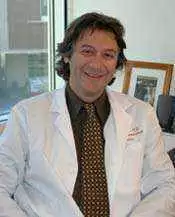.webp.f432b8e9af09a8321d00fac15e2b0168.webp)
Celiac.com 04/09/2014 - The human gastrointestinal tract contains approximately 1014 bacterial cells that form a unique, diverse and very dynamic microbial ecosystem also known as gut microbiota. The genomes of all intestinal microbes form the “microbiome”, representing more than 100 times the human genome. The composition of gut microbiota is crucial for human health. Normal gut microbiota enhances digestive processes, produces certain vitamins and nutrients, facilitates absorptive processes, participates in development and maturation of the immune system and limits colonization of the gut by pathogenic microorganisms. It has been demonstrated that the following predominant microorganisms constitute for the normal gut microbiota: Bacteroides, Clostridium, Eubacterium, Veillonella, Ruminococcus, Bifidobacterium, Fusobacterium, Lactobacillus, Peptostreptococcus and Peptococcus. Diet is a major environmental factor influencing gut microbiota diversity and functionality.
Abnormalities in the composition of normal gut microbiota, also known as dysbiosis, frequently result in the development of chronic inflammatory, autoimmune and atopic processes not only within the gut but also in the distant body compartments such as skin, exocrine glands, the brain, muscles and joints.
Celiac.com Sponsor (A12):
It is well recognized that people affected by poorly controlled celiac disease have detectable dysbiosis.
Compared to healthy individuals, people with active celiac disease are characterized by higher numbers of Gram-negative bacteria, known to activate pro-inflammatory processes, and lower numbers of Gram-positive bacteria benefiting the gastrointestinal tract and anti-inflammatory responses. Furthermore, recent studies of children with celiac disease showed that even a strict compliance with a gluten-free diet does not completely restore the normal gut microbiota. Di Cagno and colleagues analyzed the composition of gut microbiota in children with celiac disease on a strict gluten-free diet as compared to a group of matched, non-celiac controls. The study showed that the levels of Lactobacillus, Enterococcus and Bifidobacteria were significantly higher in fecal samples from healthy children rather than from celiac children. On the contrary, cell counts of potentially pathogenic microorganisms such as Bacteroides, Staphylococcus, Salmonella, Shighella and Klebsiella were significantly higher in celiac children compared to healthy children.
Based on the aforementioned data, it is obvious to propose that probiotics, defined as viable microorganisms benefiting gastrointestinal health, may serve as a valuable addition to the maintenance protocols for those with celiac disease.
Well established probiotic effects include:
- Beneficial effects on dysbiosis including control of yeast (Candida albicans) overgrowth
- Facilitation of pathogenic bacteria elimination (for example, Clostridium difficile and Helicobacter pylori)
- Reduction of local and systemic inflammatory responses
- Prevention of autoimmune and allergic reactions
- Prevention and treatment of antibiotic-associated diarrhea
- Normalization of intestinal contractions and stool consistency
- Reduction of the concentration of cancer-promoting enzymes and metabolites in the gut
- Prevention of upper respiratory and urogenital infections
- Cholesterol-lowering activity
- Experimental data indicate that probiotics can benefit celiac disease.
Lindfors K. and colleagues showed that live probiotic, Bifidobacterium lactis, bacteria inhibit the toxic effects induced by wheat gliadin in intestinal epithelial cell culture.
Papista C. et al. demonstrated (in a mouse model) that probiotics can prevent intestinal damage of celiac disease.
The published data on the beneficial effects of probiotics in celiac patients is limited. Our clinical experience (Institute for Specialized Medicine – www.ifsmed.com) indicates that appropriately selected probiotics significantly reduce diarrhea and bloating in patients with gluten intolerance and celiac disease. Furthermore, we see positive reduction of gluten-associated joint and muscle pain, fatigue and brain fog as well as on gut colonization with yeast. Probiotics also normalize markers of inflammation (for example, C-reactive protein) and markers of mucosal immune responses (for example, fecal secretory immunoglobulin A – sIgA). Typically, the benefits of probiotics administration cannot be seen instantly. It takes at least 4-6 months to see measurable benefits.
The choice of probiotics is another difficult issue for an inexperienced consumer.
The following probiotic strains may benefit those with celiac disease and gluten intolerance:
a. Lactobacillus acidophilus is a species of Lactobacilli which occurs naturally in the human and animal gastrointestinal tract and in many dairy products. The L. acidophilus strain DDS-1 is one of the best characterized probiotic strains in the world. The medicinal properties of L. acidophilus DDS-1 include: production of lactic acid supporting good bacteria in the gut, production of B and K vitamins, prevention of colon cancer, prevention of ‘traveler’s diarrhea’, inhibition of gastric/duodenal ulcers caused by Helicobacter pylori, reduction of symptoms of eczema and atopic dermatitis, reduction of serum cholesterol level, fermentation of lactose and reduction of symptoms of lactose intolerance, and reduction of intestinal pain.
b. Lactobacillus plantarum is a Gram-positive bacterium naturally found in many fermented food products including sauerkraut, pickles, brined olives, Korean kimchi, sourdough, and other fermented plant material, and also some cheeses, fermented sausages, and stockfish. The medicinal properties of L. plantarum include: production of D- and L-isomers of lactic acid feeding beneficial gut bacteria, production of hydrogen peroxide killing pathogenic bacteria, production of enzymes (proteases) degrading soy protein and helping people with soy intolerance, synthesis of amino-acid L-lysine that promotes absorption of calcium and the building of muscle tissue, production of enzymes (proteases) digesting animal proteins such as gelatin and helping people with pancreatic insufficiency.
c. Lactobacillus casei is a species of Lactobacilli found in the human intestine and mouth. The medicinal properties of L. casei include: production of lactic acid assisting propagation of desirable bacteria in the gut, fermentation of lactose and helping people with lactose intolerance, fermentation of beans causing flatulence upon digestion.
d. Lactobacillus rhamnosus is a species of Lactobacilli found in yogurt and other dairy products. The medicinal properties of L. rhamnosus include: production of lactic acid supporting good bacteria in the gut, production of bacteriocins and hydrogen peroxide killing pathogenic bacteria, prevention of diarrhea of various nature, prevention of upper respiratory infections, reduction of symptoms of eczema and atopic dermatitis, affecting GABA neurotransmitting pathway and reducing symptoms of anxiety.
e. Lactobacillus salivarius is a species of Lactobacilli isolated from saliva. The medicinal properties of L. salivarius include: production of lactic acid supporting good bacteria in the gut, reduction of inflammatory processes causing colitis and inflammatory arthritis, prevention of colon cancer.
f. Bifidobacterium bifidus is a Gram-positive bacterium which is a ubiquitous inhabitant of the human gastrointestinal tract. B. bifidus are capable of fermenting various polysaccharides of animal and plant origin. The medicinal properties of B. bifidus include: production of hydrogen peroxide killing pathogenic bacteria, modulation of local immune responses, production of vitamins B, K and folic acid, prevention of colon cancer, bioconversion of a number of dietary compounds into bioactive molecules.
g. Bifidobacterium lactis is a Gram-positive bacterium which is found in the large intestines of humans. The medicinal properties of B. lactis include: production of hydrogen peroxide killing pathogenic bacteria, modulation of local immune responses, production of vitamins B, K and folic acid, prevention of colon cancer.
h. Lactococcus lactis is a Gram-positive bacterium used in the production of buttermilk and cheese. The medicinal properties of L. lactis include: production of lactic acid supporting good bacteria in the gut, prevention of colon cancer, fermentation of lactose and reduction of symptoms of lactose intolerance.
i. Saccharomyces boulardii is a probiotic strain of yeast first isolated from lychee and mangosteen fruit. Upon consumption, S. boulardii remains within the gastrointestinal lumen, and maintains and restores the natural flora in the large and small intestine. There are numerous randomized, double-blind placebo-controlled studies showing the efficacy of S. boulardii in the treatment and prevention of various gastrointestinal disorders. Potential indications for use of Saccharomyces boulardii in humans include: 1) diarrhea/traveler’s diarrhea/antibiotic-associated diarrhea, 2) infection with Clostridium difficile/pseudomembranous colitis, 3) irritable bowel syndrome, 4) ulcerative colitis and Crohn’s disease, 5) partial IgA deficiency, 6)peptic-ulcer disease due to Helicobacter pylori. Published data also indicate that enzymes produced by S. boulardii can digest alpha-gliadin and related molecules.
j. Bacillus coagulans, also known as Lactobacillus sporogenes, is a gram-positive, spore-forming probiotic which is characterized by the increased survival in acidic gastric environment and in bile-acid-associated duodenal environment as compared to the commonly used probiotic microorganisms. Bacillus coagulans do not adhere to the human intestinal epithelium and is completely eliminated in four to five days unless chronic administration is maintained. Once in the intestines, Bacillus coagulans is activated and releases anti-inflammatory molecules or acts indirectly to eradicate organisms in the gut responsible for the inflammatory immune response. Activated Bacillus coagulans produces bacteriocins and lowers local pH by producing L(+) lactic acid that, along with competition for sites of mucosal adherence, works to dislodge and eliminate any antagonizing microbes that may be contributing to an inflammatory response. Bacillus coagulans also produces short-chain fatty acids such as butyric acid, a compound known to support the health and healing of cells in the small and large intestines and to contribute to modulation of the mucosal immune system.
To achieve therapeutic responses, the daily dose of the probiotics should be at least 25 billion CFUs (colony-forming units) and above. We recommend taking probiotics on an empty stomach either 20-30 minutes before breakfast or one-two hours after dinner with plenty of fluids. In those taking antibiotics, the time of the probiotic administration needs to be spaced out from that of antibiotics for at least several hours.
References:
- Papista C, Gerakopoulos V, Kourelis A, Sounidaki M, Kontana A, Berthelot L, Moura IC, Monteiro RC, Yiangou M. Gluten induces coeliac-like disease in sensitised mice involving IgA, CD71 and transglutaminase 2 interactions that are prevented by probiotics. Lab Invest. 2012 Feb 13. doi: 10.1038/labinvest.2012.13.
- Sanz Y, De Pama G, Laparra M. Unraveling the ties between celiac disease and intestinal microbiota. Int Rev Immunol. 2011 Aug;30(4):207-18.
- de Vrese M, Schrezenmeir J. Probiotics, prebiotics, and synbiotics. Adv Biochem Eng Biotechnol. 2008;111:1-66.
- Lindfors K, Blomqvist T, Juuti-Uusitalo K, Stenman S, Venäläinen J, Mäki M, Kaukinen K. Live probiotic Bifidobacterium lactis bacteria inhibit the toxic effects induced by wheat gliadin in epithelial cell culture. Clin Exp Immunol. 2008 Jun;152(3):552-8.
- Raffaella Di Cagno, Maria De Angelis, Ilaria De Pasquale, Maurice Ndagijimana, Pamela Vernocchi, Patrizia Ricciuti, Francesca Gagliardi, Luca Laghi, Carmine Crecchio, Maria Elisabetta Guerzoni, Marco Gobbetti, Ruggiero Francavilla. Duodenal and faecal microbiota of celiac children: molecular, phenotype and metabolome characterization. BMC Microbiology 2011, 11:219.







Recommended Comments
Create an account or sign in to comment
You need to be a member in order to leave a comment
Create an account
Sign up for a new account in our community. It's easy!
Register a new accountSign in
Already have an account? Sign in here.
Sign In Now